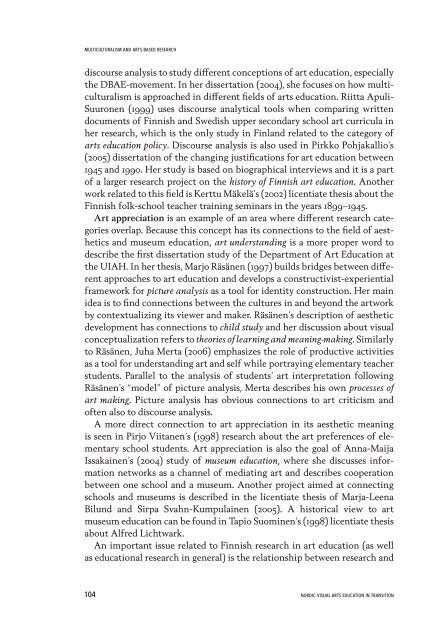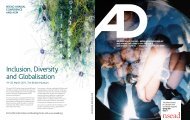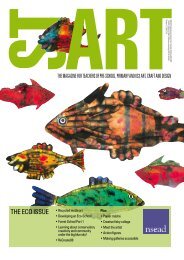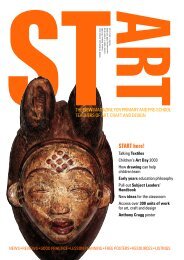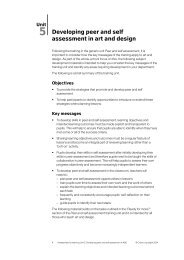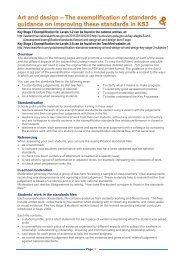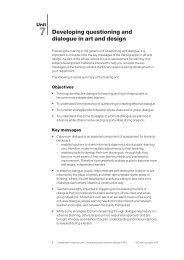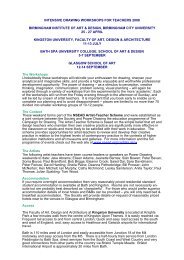Research in Visual Arts Education - Bilderlernen.at
Research in Visual Arts Education - Bilderlernen.at
Research in Visual Arts Education - Bilderlernen.at
Create successful ePaper yourself
Turn your PDF publications into a flip-book with our unique Google optimized e-Paper software.
MULTICULTURALISM AND ARTS-BASED RESEARCHdiscourse analysis to study different conceptions of art educ<strong>at</strong>ion, especiallythe DBAE-movement. In her dissert<strong>at</strong>ion (2004), she focuses on how multiculturalismis approached <strong>in</strong> different fields of arts educ<strong>at</strong>ion. Riitta Apuli-Suuronen (1999) uses discourse analytical tools when compar<strong>in</strong>g writtendocuments of F<strong>in</strong>nish and Swedish upper secondary school art curricula <strong>in</strong>her research, which is the only study <strong>in</strong> F<strong>in</strong>land rel<strong>at</strong>ed to the c<strong>at</strong>egory ofarts educ<strong>at</strong>ion policy. Discourse analysis is also used <strong>in</strong> Pirkko Pohjakallio’s(2005) dissert<strong>at</strong>ion of the chang<strong>in</strong>g justific<strong>at</strong>ions for art educ<strong>at</strong>ion between1945 and 1990. Her study is based on biographical <strong>in</strong>terviews and it is a partof a larger research project on the history of F<strong>in</strong>nish art educ<strong>at</strong>ion. Anotherwork rel<strong>at</strong>ed to this field is Kerttu Mäkelä’s (2002) licenti<strong>at</strong>e thesis about theF<strong>in</strong>nish folk-school teacher tra<strong>in</strong><strong>in</strong>g sem<strong>in</strong>ars <strong>in</strong> the years 1899–1945.Art appreci<strong>at</strong>ion is an example of an area where different research c<strong>at</strong>egoriesoverlap. Because this concept has its connections to the field of aestheticsand museum educ<strong>at</strong>ion, art understand<strong>in</strong>g is a more proper word todescribe the first dissert<strong>at</strong>ion study of the Department of Art <strong>Educ<strong>at</strong>ion</strong> <strong>at</strong>the UIAH. In her thesis, Marjo Räsänen (1997) builds bridges between differentapproaches to art educ<strong>at</strong>ion and develops a constructivist-experientialframework for picture analysis as a tool for identity construction. Her ma<strong>in</strong>idea is to f<strong>in</strong>d connections between the cultures <strong>in</strong> and beyond the artworkby contextualiz<strong>in</strong>g its viewer and maker. Räsänen’s description of aestheticdevelopment has connections to child study and her discussion about visualconceptualiz<strong>at</strong>ion refers to theories of learn<strong>in</strong>g and mean<strong>in</strong>g-mak<strong>in</strong>g. Similarlyto Räsänen, Juha Merta (2006) emphasizes the role of productive activitiesas a tool for understand<strong>in</strong>g art and self while portray<strong>in</strong>g elementary teacherstudents. Parallel to the analysis of students’ art <strong>in</strong>terpret<strong>at</strong>ion follow<strong>in</strong>gRäsänen’s “model” of picture analysis, Merta describes his own processes ofart mak<strong>in</strong>g. Picture analysis has obvious connections to art criticism andoften also to discourse analysis.A more direct connection to art appreci<strong>at</strong>ion <strong>in</strong> its aesthetic mean<strong>in</strong>gis seen <strong>in</strong> Pirjo Viitanen’s (1998) research about the art preferences of elementaryschool students. Art appreci<strong>at</strong>ion is also the goal of Anna-MaijaIssaka<strong>in</strong>en’s (2004) study of museum educ<strong>at</strong>ion, where she discusses <strong>in</strong>form<strong>at</strong>ionnetworks as a channel of medi<strong>at</strong><strong>in</strong>g art and describes cooper<strong>at</strong>ionbetween one school and a museum. Another project aimed <strong>at</strong> connect<strong>in</strong>gschools and museums is described <strong>in</strong> the licenti<strong>at</strong>e thesis of Marja-LeenaBilund and Sirpa Svahn-Kumpula<strong>in</strong>en (2005). A historical view to artmuseum educ<strong>at</strong>ion can be found <strong>in</strong> Tapio Suom<strong>in</strong>en’s (1998) licenti<strong>at</strong>e thesisabout Alfred Lichtwark.An important issue rel<strong>at</strong>ed to F<strong>in</strong>nish research <strong>in</strong> art educ<strong>at</strong>ion (as wellas educ<strong>at</strong>ional research <strong>in</strong> general) is the rel<strong>at</strong>ionship between research and104 NORDIC VISUAL ARTS EDUCATION IN TRANSITION


